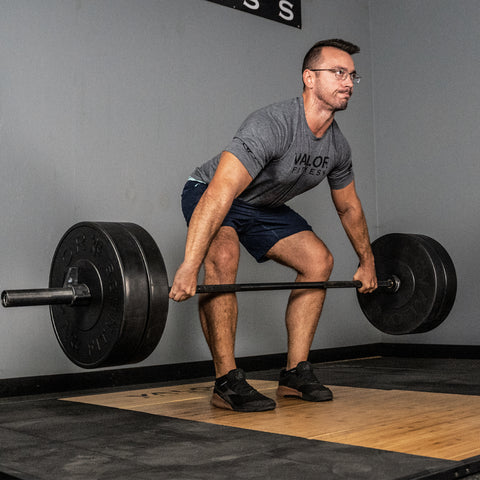
Low back pain is one of the most common causes of disability in the United States. Up to 80% of adults experience lower back pain at some point in their lives regardless of their age or fitness level. But while many athletes and weightlifters may experience some form of painful episode in their low back, sometimes the advice we can get from health professionals is not the best.
Maybe you have had a doctor advise you to “stop deadlifting”, or (even worse) “get an injection”, but don’t take either of these suggestions as a hard, fast way to solve anything.

This blog is not to discredit health professionals in any way, but to encourage you to do your own research and, with the help of the right people, come up with a plan to get you back in the gym. As health and wellness is becoming a more popular way to treat common issues we experience, it is clear there are ways to correct certain problems without making rash or potentially harmful decisions.
While not every injury (not even every low back injury) is the same and requires a slightly different approach, here are 3 Simple Ways to Deal with Low Back Pain from a friend who experienced chronic low back pain for over a year (AKA me):
1. Be Positive
It’s easier said than done, super cheesy, and maybe a little cringeworthy too. But it’s the truth. When you first start experiencing pain it’s not only worrying, but it’s super disheartening and easy to think the worst. A positive outlook is without a doubt the most important thing to help you get through any kind of hardship, and low back pain is no different.
The key thing to remember is that low back pain is not a death sentence, even though it can impact daily life activities. It is an experience that can be managed, worked around, and ultimately fixed. All you need to do is be patient and look forward to getting better.
As previously mentioned, this blog is not to discredit or say you should not see a health professional. There are many chiropractors, physical therapists, etc. out there that will put you on the right path and get you back to where you once were without suggesting any be-all end-all measures.
2. Strengthen/Stabilize Your Core and Correct Any Imbalances
Efficient core stability is critical for avoiding and improving symptoms of low back pain, as it limits excessive and unwanted motion of the spine so you can perform your favorite exercises in the gym. What is the “core”? The core is made up of all the muscles surrounding your spine, including the front and side abdominal muscles, the erector muscles in the back, larger muscles that span multiple joints like the lats and psoas, and even the glutes! Without a strong and stable core, you will end up putting more stress on ligaments, bones, and eventually discs.

While there are many ways to strengthen your core, including indirectly while deadlifting and many other exercises, there are 3 key exercises determined by Dr. Stuart McGill known as the Big 3 that most effectively stress the core muscles without aggravating the spine. These 3 exercises are the curl-up, the side plank, and the bird dog. If you perform these 3 exercises every day, you will certainly feel a difference not only in your level of pain, but you will feel more powerful and stable during your deadlift, bench, squat, cleans, and snatches.
In addition to enhancing core stability, it is important to determine and address any imbalances you may have in your body. For example, many athletes may experience a hip shift where their hips suffer from a mobility limitation. This mobility limitation (or imbalance) can cause an anterior, posterior, or lateral hip shift that has numerous side effects including, but not limited to, low back pain.
Addressing this kind of imbalance may require the help of a physical therapist, chiropractor, or even a licensed coach, but you may be able to determine this on your own as well. Sticking with the hip shift example, performing the Faber Test on your own on both sides can help you determine if there is a mobility imbalance in the hips. If this is the case, performing the Assisted Hip Airplane with the imbalanced side planted on the ground can correct a hip imbalance/shift over time.
So, while you may be experiencing pain in the low back, keep in mind that this could be due to weakness, lack of mobility, or an imbalance in a different part of the body (i.e. hips, glutes, core). Determine and address the issue to relieve your symptoms of low back pain.
3. Modify and MOVE!
While it is important to take a bit of a step back from lifting when experiencing pain at first, it is important to remember that complete rest will not cure your back pain. Simply taking a few weeks off until the pain subsides will likely result in the pain returning once you begin to lift again, and in some cases it can get worse. Avoiding certain movements and exercises that cause your pain is only a short part on the road to recovery – addressing the root of the problem, beginning with the 2 aforementioned steps, is what will ultimately aid your healing in the long term.
Movement is medicine. Moving correctly and moving well is key. There is always some form of exercise that can fix any kind of pain. Keep in mind, it is important to modify while building back up to full strength.
Maybe you feel pain when doing cleans and snatches. Should you just stop moving? By now you know the answer is NO! You can modify (and move) by performing kettlebell swings to get a similar stimulus while you work to address the root of the problem. Have pain when back squatting? No problem – a belt squat will take the pressure off your spine and help you build strong legs and glutes. Simply loop a dip belt through some Olympic plates and squat down on an elevated surface. There is always a way to keep moving while you work through and improve your symptoms of back pain.
Note: these examples are not hard and fast rules to live by. While they are down to personal preference on how you choose to modify, these are just a few possible ways to show that you can achieve a similar stimulus by modifying and moving during your recovery.

While low back pain can be extremely difficult to work through, the important thing to remember is that it is not the end of the world. We are blessed to live during a time where we know there are ways to work around and recover from injuries. If you are experiencing low back pain, remember to stay positive, strengthen your core muscles, and keep moving!
Have you had issues with low back pain? What are some practices that helped you recover?


This was super helpful- Thanks Neil!